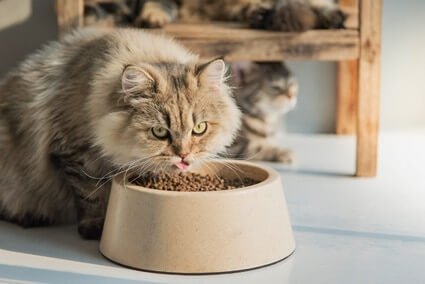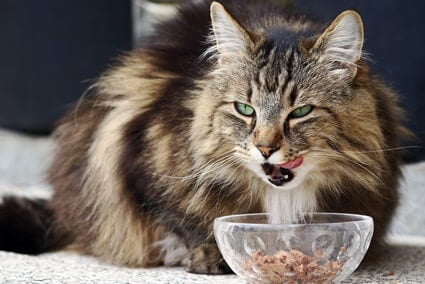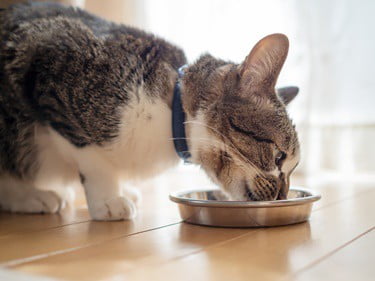Occasional gags and coughs are common when cats are eating food. However, if you find that your cat is gulping, gagging, coughing, having trouble chewing or swallowing frequently, it may have a health problem.
If your cat is always trying to swallow, along with coughing, gagging, or drooling, it could have dysphagia. This results in weight loss due to the cat’s inability to eat. Hairballs or asthma may also lead to gulping sounds in cats.
If you notice your cat behaving unusually, having difficulty eating, or gulping or gagging during meals, it should be seen by a vet. Not treating the problem could lead to further complications that make treatment more difficult.
What Causes Gulping in Cats When Swallowing?
The most common explanation for cats gulping when swallowing is dysphagia, but treatments depend on the cause.
Hairballs can cause cats to take gulps. However, if gulping is frequent, it may signify feline asthma, which is often mistaken for hairballs.
Feline Dysphagia
Dysphagia is the medical term for difficulty swallowing. It can occur as oral dysphagia, pharyngeal dysphagia, or cricopharyngeal dysphagia.
This condition can happen for many reasons, ranging from anatomical to neuromuscular causes. A cat with dysphagia may make gulping sounds while attempting to swallow or eat unusually.
Some of the causes of dysphagia are treatable, while others aren’t. Although dysphagia is a mild condition in some cats, it can lead to severe distress and weight loss in others.
Symptoms
A cat with oral dysphagia may chew unusually, such as tilting its head backward or to one side while eating.
Some cats may have food lodged in the cheeks folds of their mouth devoid of any saliva. Dysphagia can look like hiccups, while others may drop their food or appear as though they’re trying to swallow a lot but not eating.
Dysphagia in the mouth usually occurs due to:
- Dental disease
- Swelling or deterioration of the muscles responsible for chewing
- Paralysis of the tongue or jaw
- Inability to open the mouth
In the case of pharyngeal dysphagia (dysphagia in the pharynx), a cat may be able to grab its food but will have difficulty swallowing it.
A cat with this disorder may make repeated attempts to swallow. This is often accompanied by excessive chewing, gagging, and flexing the head and neck. After eating, there may be a weak gag reflex, followed by nasal discharge.
Another type of dysphagia (cricopharyngeal dysphagia), which occurs at the end of the pharynx, causes gagging in cats during eating. The cat may swallow after multiple attempts but is likely to do some gagging and coughing.
A cat with this condition may throw its food back up, so they’re usually emaciated.
Causes
The most common anatomical and mechanical causes of dysphagia in cats are as follows:
- Abscess
- Pharyngeal inflammation
- Inflammatory growths
- Foreign body in the mouth
- Mouth tissue packed with white cells
- Enlarged lymph nodes behind the pharynx
- A tumor
- Lower jaw fracture
- Jaw joint disorders (from luxation or fracture)
- Cleft palate
- Saliva draining into the body through a pocket
- Injury to the mouth
- Lingual frenulum disorder (problem with a short band of tissue under the tongue)
Dysphagia can occur due to pain. The following are causes of pain-induced dysphagia in cats:
- Inflammation of the mouth, tongue, or pharynx
- Dental disease
- Injury or trauma to the jaw
Causes of dysphagia from paralysis include the following:
- Muscular dystrophy
- Neosporosis, Toxoplasmosis, and other infectious polymyositis
- Multiple nerve disorders
- Myoneural junction problems
- Hereditary muscle inflammation
Feline dysphagia can be due to neuromuscular disorders such as cranial nerve deficits, tongue paralysis, and paralysis/inflammation of the muscles responsible for chewing. Rabies and certain brain-related disorders may also contribute to the onset of this condition.

Diagnosis
Your vet may ask you about the onset and type of symptoms. They’ll also be interested in learning about any events that may have led to the disorder, such as a recent injury, infection, or disease.
During the examination, your vet needs to differentiate vomiting from dysphagia. Dysphagia doesn’t involve abdominal contractions that occur with vomiting.
The physical test is followed by a complete blood profile, a chemical blood profile, and a urinalysis. Your vet will order these tests to check if your cat has kidney disease, an infectious disease, or muscle injury.
Your vet may draw blood to run lab tests so that they can rule out inflammatory disorders of the muscles involved in chewing. Examples of such disorders include immune-mediated disorders, masticatory muscle myositis, myasthenia gravis, hypothyroidism, and hyperadrenocorticism.
X-ray and ultrasound images of your cat’s skull and neck will locate any abnormalities, such as masses in the pharynx. Your vet may take tissue samples.
If a brain tumor is suspected, an MRI and CT scan may be employed to determine the tumor’s location and its severity.
Treatment
Treatment often depends on the cause. For example, if an abnormality of the mouth causes difficulty swallowing, treatment may involve helping your cat eat by placing a ball of food at the back of its throat.
If your cat has cricopharyngeal dysphagia or pharyngeal dysphagia, you may need to assist your cat in eating by lifting its head and neck while swallowing its food.
A stomach tube may be needed if your cat cannot maintain a healthy weight. If a foreign body is detected during diagnosis, surgery may be needed to remove it.
Nutritional support is critical during treatment, and you may need to switch your cat’s food consistency and position during feeding.
Aside from a feeding tube, intravenous feeding may be needed occasionally, depending on the condition’s cause. Antibiotics may be needed to fight off or prevent bacterial infection.
Surgery will be required if your cat has a jaw or palate fracture, dental disease, or upper airway abnormalities. Corticosteroids for inflammation of the mouth tissues may be prescribed.
Hairballs in Cats
Hairballs cause gagging, gulping, retching, and hacking sounds in cats. If not dealt with correctly, hairballs can lead to intestinal blockages. Although cats will always groom themselves, there are ways to control hairballs.
Symptoms
A hairball problem will result in your cat trying to gag it out, often followed by vomiting the hairball out. Call your vet if you notice the following symptoms as they could indicate a lethal blockage:
- Ongoing gagging, vomiting, hacking, or retching with no success in producing a hairball
- Poor appetite
- Lethargy
- Diarrhea
- Constipation
As the hairball blockage grows, you may notice swelling or a lump around the stomach or throat.
Causes
Cats have tiny hook-like structures on their tongues that latch on to dead, loose hair on their bodies. When a cat grooms itself, it usually swallows any hair caught by its tongue.
In most cases, the hair passes with no issues. However, some hair may remain in the stomach, accumulate over time, and form a hairball.
Usually, a cat will vomit the hairball out to remove it from its body. Hairballs are thin and elongated. Cats have a narrow esophagus, which means that the hairball will form into a tube-like structure on its way out.
Hairballs are most common in long-haired breeds, such as Maine Coons and Persians. Hairballs may be more common during the summer as warm weather can cause cats to shed more fur.
Cats that shed a lot or groom themselves excessively are more susceptible to hairballs because they swallow more of their fur.
Even if your cat didn’t have any hairballs when it was a kitten, it could develop hairballs later in life. This is normal as cats become more skilled in grooming as they grow older and are likely to catch more fur.
Diagnosis
If your cat coughs up hairballs, you may notice vomit containing pieces of hair along with fluid and food. Symptoms such as loss of appetite, frequent vomiting, and lethargy may indicate that there’s an intestinal blockage.
Your vet may order radiographs and a blood test to determine whether your cat has an intestinal blockage. Surgical removal is the only option if your cat has an intestinal blockage due to hairballs.
Home Treatment Options
Due to a cat’s demanding grooming routine, there isn’t much you can do to prevent hairballs completely. However, you can reduce the amount of dead hair on your cat.
Brush Your Cat Regularly
Brushing or combing your cat every day, especially if it is a long-hair breed, is one of the most effective ways of minimizing hairballs.
By reducing the amount of loose fur on your cat’s body, you’re also reducing the fur that ends up inside its stomach. Brushing is also a good way for an owner to build a strong bond with their cat.
If you’re having trouble getting your cat used to regular brushing, try gradually incorporating a few minutes of grooming each day until your cat grows accustomed to it.
Manage Overgrooming
If you suspect that your cat’s hairball issue is due to excessive grooming, pay attention to how your cat feels.
According to the Frontiers in Veterinary Science, excessive grooming is often a sign of stress as grooming is an effective self-soothing method.
Some causes of stress in cats include changing a litter box or cat bed position, more guests, a new pet, or a dominant cat in a multi-cat home.
Overgrooming can cause large, bare patches on your cat’s skin. Whether your cat’s compulsive grooming results from stress or something else, you can divert its attention away from licking its coat with another activity.
Teach your cat to play with a new interactive toy, and make sure you include at least 15 minutes of one-on-one time every day to reduce stress.
Specialized Hairball Formula
Many companies offer hairball-reducing cat foods. These foods often contain more fiber that will improve your cat’s coat, reduce shedding, and facilitate the movement of hairballs through the digestive tract.
You can talk to your vet about using a hairball product, such as a mild laxative that can help your cat pass the hairball more easily.
Drink More Water
Although making your cat drink more water won’t cure its hairball problem, it’ll keep its digestive tract working optimally.
Water is essential for the passage of stools as it adds more lubrication. Not drinking enough water can dehydrate your cat’s stools, resulting in constipation and difficulty removing hair.
Feline Asthma
Although the definition of asthma is the subject of much debate, most researchers and clinicians agree that feline asthma results from an allergic reaction to allergens that have been inhaled. These particles activate a cat’s immune system, stimulating the production of specific antibodies.
According to Cornell University College of Veterinary Medicine, 1%-5% of cats have feline asthma, and this can cause hacking, gulping, wheezing, coughing, and difficulty breathing in cats.
Common triggers include dust, pollen, smoke, mold, fumes, aerosols, and fragrances. Sometimes emotional stress, changes in weather conditions, and heat and cold can also trigger asthma attacks.
When a cat inhales an allergen, its immune system recognizes it, leading to events that bring numerous types of immune cells into its airways, resulting in inflammation, swelling, irritation, and constriction of the respiratory tract.
An allergic reaction can cause the diameter of a cat’s airways to reduce, which leads to mucus accumulation. Together, these events can restrict airflow, resulting in spasms of the airways and breathing difficulties in a cat.
Risk Factors
Certain breeds, such as Burmese, Siamese, and other oriental breeds, are more susceptible to asthma. Also, according to the Journal of Feline Medicine and Surgery, asthma is likelier to occur in cats aged 2-8.
Signs
The most common symptoms of allergies include gagging, wheezing, and coughing. In most cases, this cough may resemble a hairball cough, which is why many owners mistake an asthma attack for a hairball problem.
However, hairballs are often accompanied by retching and vomiting, which are usually absent in feline asthma. Hairballs are also more gastrointestinal in origin, whereas asthma is a respiratory condition.
When a cat with asthma coughs, it’ll usually extend its head and neck in a squatted position. It can sound moist or dry. Some cats with asthma may stick their tongue out slightly during coughing. Usually, it appears as if the cat is coughing up some mucus and swallowing it.
Other symptoms include lethargy, decreased activity, breathing difficulties, increased breathing effort, and exhaustion even from normal activities. Some cats breathe through an open mouth when their condition is severe when they’re having trouble moving air from their lungs.

Diagnosis
Your vet will utilize your cat’s medical history, gathered information, and test results to diagnose the condition.
If your vet thinks that your cat has asthma, they’ll consider its medical history, imaging studies, and microscopic analysis of cells from airway secretion. Allergy testing and blood work may also be required. Your vet may also use radiographs, bronchoscopy, and computed tomography (CT) to check and assess your cat’s lung condition.
If your cat has asthma, a radiograph will show bright branching patterns along the airways that are characteristic of feline asthma. The pattern is formed by inflammatory cells that have accumulated.
The radiograph may help indicate any changes in lung size. Constricted airways caused by asthma can trap air inside the lungs, overinflate them, and appear larger.
CT scans that employ X-rays to produce 3D views of the body are used to diagnose asthma and distinguish it from other conditions that cause airway problems.
Your vet may use bronchoscopy, where a flexible camera will be passed through the mouth and into the airways. Bronchoscopy is usually performed to analyze the airways and collect cell samples.
An asthmatic cat will show distinct changes in the lining of the airways. Furthermore, cell analysis may show high numbers of inflammatory cells. However, these distinguishing factors may be present in other respiratory diseases.
Other conditions that can result in similar symptoms to feline asthma include chronic bronchitis, parasitic invasion into the lungs, lungworm infestation, and other infectious diseases that cause pneumonia.
Treatment
Treatment is based on corticosteroids and bronchodilators. Prednisolone, oral prednisone, and inhaled corticosteroids are anti-inflammatory drugs designed to reduce inflammation in the airways.
Corticosteroids may cause side effects, such as:
- Increased thirst
- Increased appetite
- Increased urination
- Weight gain
- Diabetes
- Lower resistance to infection
- Behavioral changes
Bronchodilators are utilized to open the airways and have minimal side effects. However, bronchodilators shouldn’t be used without a special inhalant mask.
Antihistamines and anti-leukotrienes may be prescribed.
Prognosis
In most cases, feline asthma is a progressive condition that doesn’t improve over time. There’s no cure for asthma, and a cat may experience flare-ups irregularly and with varying intensities.
However, monitoring your cat’s respiratory demands and using medication when needed can make life easier.
Don’t be too concerned about occasional gulping in cats. Check for other related signs and symptoms when cats gulp when swallowing regularly, as this will make it easier to determine if your cat has dysphagia, hairballs, or asthma.


I would like to offer that human cat groomers are a valuable help in preventing hairballs and matting. Cats lick themselves which does not clean oils or dandruff off their skin. Getting them used to it early on is especially helpful. Clipping a santi-cut and bathing once every 6-8 weeks is helpful for the cat.
I have 2 Maine Coon Cats and if I don’t stay on top of it they will develop mats and have to be clipped short. Thank you